Optimal Control Strategy for Variable Air Volume Air-Conditioning Systems Using Genetic Algorithms
Abstract
1. Introduction
2. Generation of Simulated Reference Building and Description of VAV System
3. Optimal Control Using Genetic Algorithms
4. Results and Discussion
4.1. Effects of Changes in Supply Air Temperature
4.2. Effects of Changes in Duct Static Pressure
4.3. Comparison of Energy Consumption Levels
5. Conclusions
Author Contributions
Funding
Conflicts of Interest
References
- Navarro, L.; De Gracia, A.; Colclough, S.; Browne, M.; McCormack, S.J.; Griffiths, P.; Cabeza, L.F. Thermal energy storage in building integrated thermal systems: A review. Part 1. Active storage systems. Renew. Energy 2016, 88, 526–547. [Google Scholar] [CrossRef]
- Homod, R.Z. Analysis and optimization of HVAC control systems based on energy and performance considerations for smart buildings. Renew. Energy 2018, 126, 49–64. [Google Scholar] [CrossRef]
- Chua, K.J.; Chou, S.K.; Yang, W.M.; Yan, J. Achieving better energy-efficient air conditioning—A review of technologies and strategies. Appl. Energy 2013, 104, 87–104. [Google Scholar] [CrossRef]
- Ahmed, M.S.; Mohamed, A.; Homod, R.Z.; Shareef, H.; Sabry, A.H.; Khalid, K.B. Smart plug prototype for monitoring electrical appliances in Home Energy Management System. In Proceedings of the 2015 IEEE Student Conference on Research and Development (SCOReD), Kuala Lumpur, Malaysia, 13–14 December 2015; pp. 32–36. [Google Scholar]
- Bentley, P. An introduction to evolutionary design by computers. In Evolutionary Design by Computers; Morgan Kaufmann Publishers: San Francisco, CA, USA, 1999; pp. 1–73. [Google Scholar]
- Goldberg, D.E.; Holland, J.H. Genetic algorithms and machine learning. Mach. Learn. 1988, 3, 95–99. [Google Scholar] [CrossRef]
- Evins, R. A review of computational optimisation methods applied to sustainable building design. Renew. Sustain. Energy Rev. 2013, 22, 230–245. [Google Scholar] [CrossRef]
- Li, T.; Shao, G.; Zuo, W.; Huang, S. Genetic algorithm for building optimization: State-of-the-art survey. In Proceedings of the 9th International Conference on Machine Learning and Computing, Singapore, 24–26 February 2017; pp. 205–210. [Google Scholar]
- Bichiou, Y.; Krarti, M. Optimization of envelope and HVAC systems selection for residential buildings. Energy Build. 2011, 43, 3373–3382. [Google Scholar] [CrossRef]
- Seo, J.; Ooka, R.; Kim, J.T.; Nam, Y. Optimization of the HVAC system design to minimize primary energy demand. Energy Build. 2014, 76, 102–108. [Google Scholar] [CrossRef]
- Satrio, P.; Mahlia, T.M.I.; Giannetti, N.; Saito, K. Optimization of HVAC system energy consumption in a building using artificial neural network and multi-objective genetic algorithm. Sustain. Energy Technol. Assess. 2019, 35, 48–57. [Google Scholar]
- Ashrae, A. ASHRAE Handbook- Heating, Ventilating, and Air-conditioning (HVAC) Applications; ASHRAE: New York, NY, USA, 2011. [Google Scholar]
- Tukur, A.; Hallinan, K.P. Statistically informed static pressure control in multiple-zone VAV systems. Energy Build. 2017, 135, 244–252. [Google Scholar] [CrossRef]
- Wang, G.; Song, L. Air handling unit supply air temperature optimal control during economizer cycles. Energy Build. 2012, 49, 310–316. [Google Scholar] [CrossRef]
- Nassif, N. Performance analysis of supply and return fans for HVAC systems under different operating strategies of economizer dampers. Energy Build. 2010, 42, 1026–1037. [Google Scholar] [CrossRef]
- Rahnama, S.; Afshari, A.; Bergsøe, N.C.; Sadrizadeh, S. Experimental study of the pressure reset control strategy for energy-efficient fan operation–Part 1: Variable air volume ventilation system with dampers. Energy Build. 2017, 139, 72–77. [Google Scholar] [CrossRef]
- Moradi, H.; Setayesh, H.; Alasty, A. PID-Fuzzy control of air handling units in the presence of uncertainty. Int. J. Therm. Sci. 2016, 109, 123–135. [Google Scholar] [CrossRef]
- Afram, A.; Janabi-Sharifi, F. Theory and applications of HVAC control systems–A review of model predictive control (MPC). Build. Environ. 2014, 72, 343–355. [Google Scholar] [CrossRef]
- Building Energy Modeling 101: Stock-Level Analysis Use Case. Available online: https://www.energy.gov/eere/buildings/articles/building-energy-modeling-101-stock-level-analysis-use-case (accessed on 19 September 2019).
- Field, K.; Deru, M.; Studer, D. Using DOE commercial reference buildings for simulation studies. Proc. SimBuild 2010, 4, 85–93. [Google Scholar]
- ASHRAE. Energy Standard for Buildings Except Low-Rise Residential Buildings, ANSI/ASHRAE/IESNA Standard 90.1-2010; ASHRAE: New York, NY, USA, 2010. [Google Scholar]
- Deru, M.; Field, K.; Studer, D.; Benne, K.; Griffith, B.; Torcellini, B.; Liu, B.; Halverson, M.; Winiarski, D.; Rosenberg, M.; et al. U.S. Department of Energy Commercial Reference Building Models of the National Building Stock (NREL/TP-5500-46861); National Renewable Energy Laboratory: Lakewood, CO, USA, 2011. [Google Scholar]
- Korea Energy Agency. Building Energy Efficiency Rating System Regulation; Korea Energy Agency: Yongin City, Gyeonggi-Do, Korea, 2018. [Google Scholar]
- U.S. Department of Energy. EnergyPlus Version 8.9.0 Documentation Input Output Reference; U.S. Department of Energy: Washington, DC, USA, 2018.
- Raftery, P.; Li, S.; Jin, B.; Ting, M.; Paliaga, G.; Cheng, H. Evaluation of a cost-responsive supply air temperature reset strategy in an office building. Energy Build. 2018, 158, 356–370. [Google Scholar] [CrossRef]
- Tesiero, R.C., III. Intelligent Approaches for Modeling and Optimizing HVAC Systems. Ph.D. Thesis, North Carolina Agricultural and Technical State University, Greensboro, NC, USA, 2014. [Google Scholar]
- Seong, N. Optimization of Energy Consumption for Central HVAC System based Building Energy Management System Using Genetic Algorithm. Ph.D. Thesis, Gachon University, Seongnam-si, Gyeonggi-do, Korea, 2019. [Google Scholar]
- Ahmad, M.W.; Mourshed, M.; Yuce, B.; Rezgui, Y. Computational Intelligence Techniques for HVAC Systems: A review. In Building Simulation; Tsinghua University Press: Beijing, China, 2016; pp. 359–398. [Google Scholar]
- Ahn, B.C.; Mitchell, J.W. Optimal control development for chilled water plants using a quadratic representation. Energy Build. 2001, 33, 371–378. [Google Scholar] [CrossRef]
- Hong, G.; Kim, B.S. Development of a Data-Driven Predictive Model of Supply Air Temperature in an Air-Handling Unit for Conserving Energy. Energies 2018, 11, 407. [Google Scholar] [CrossRef]
- Taylor, S.T. VAV System Duct Main Design. ASHRAE J. 2019, 61, 54–60. [Google Scholar]
- Rahnama, S.; Afshari, A.; Bergsøe, N.C.; Sadrizadeh, S.; Hultmark, G. Experimental study of the pressure reset control strategy for energy-efficient fan operation–Part 2: Variable air volume ventilation system with decentralized fans. Energy Build. 2018, 172, 249–256. [Google Scholar] [CrossRef]
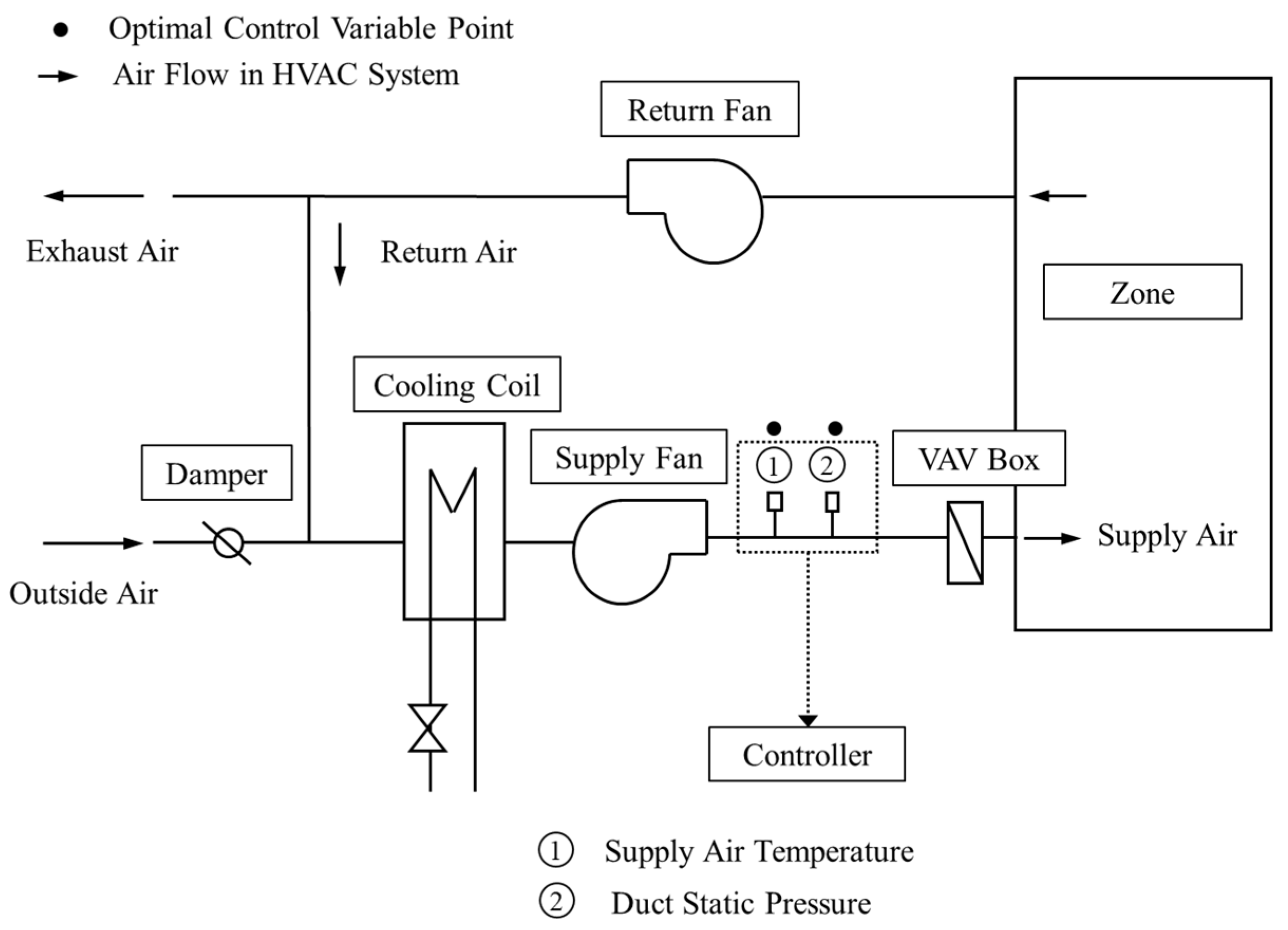
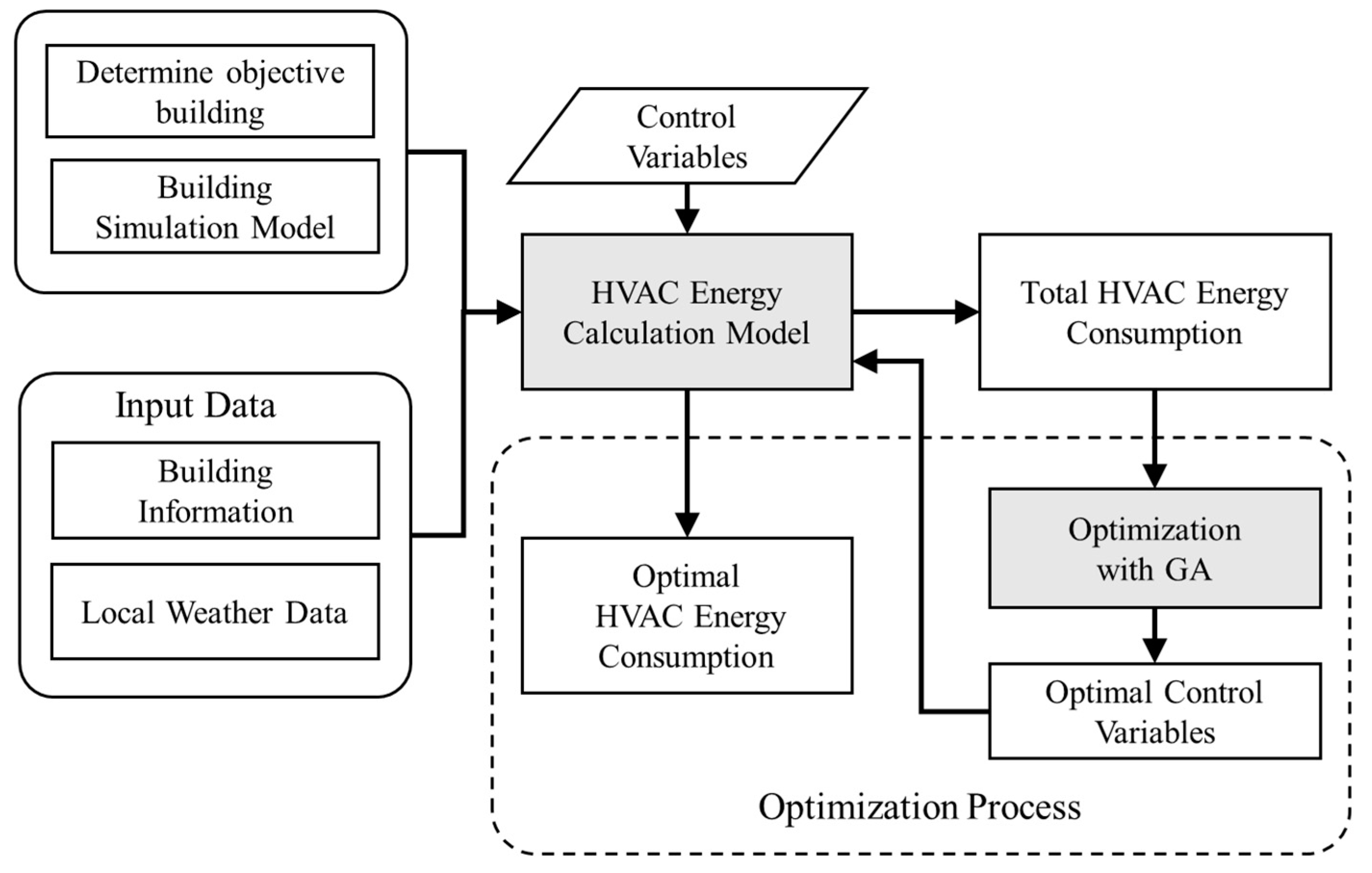
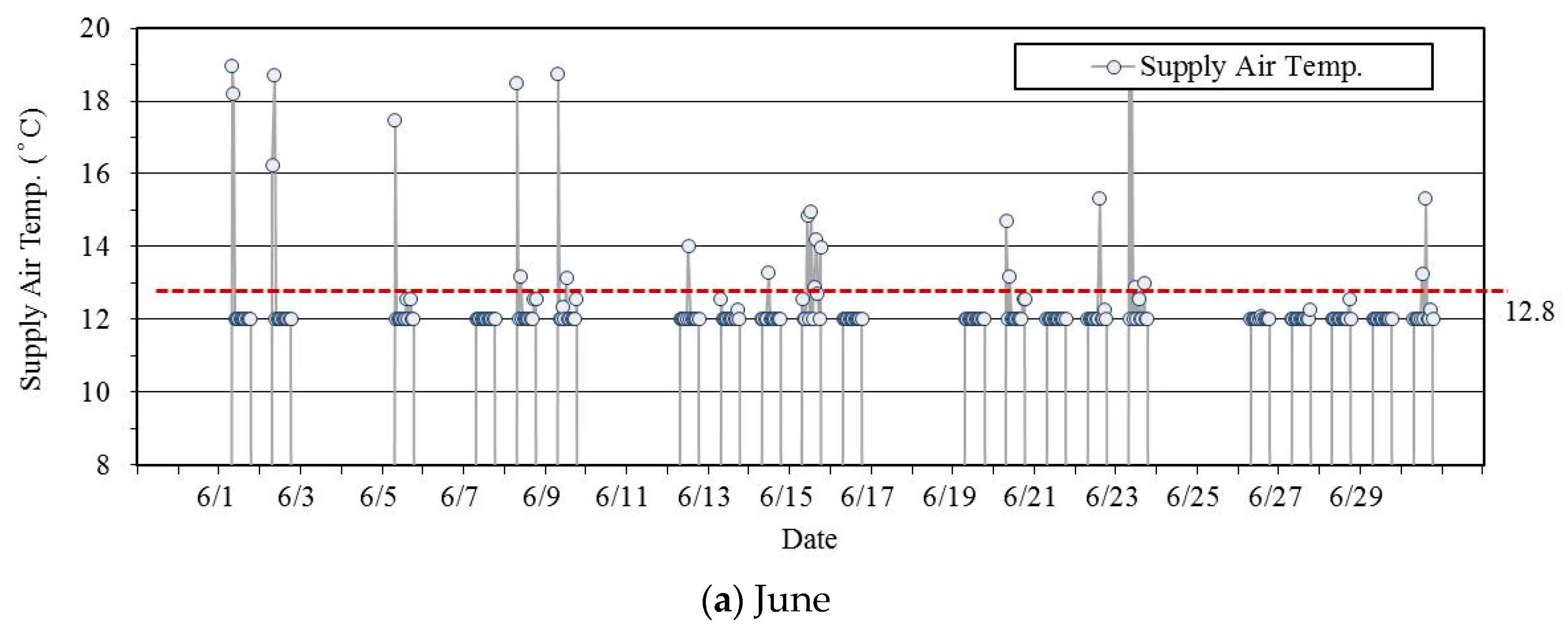
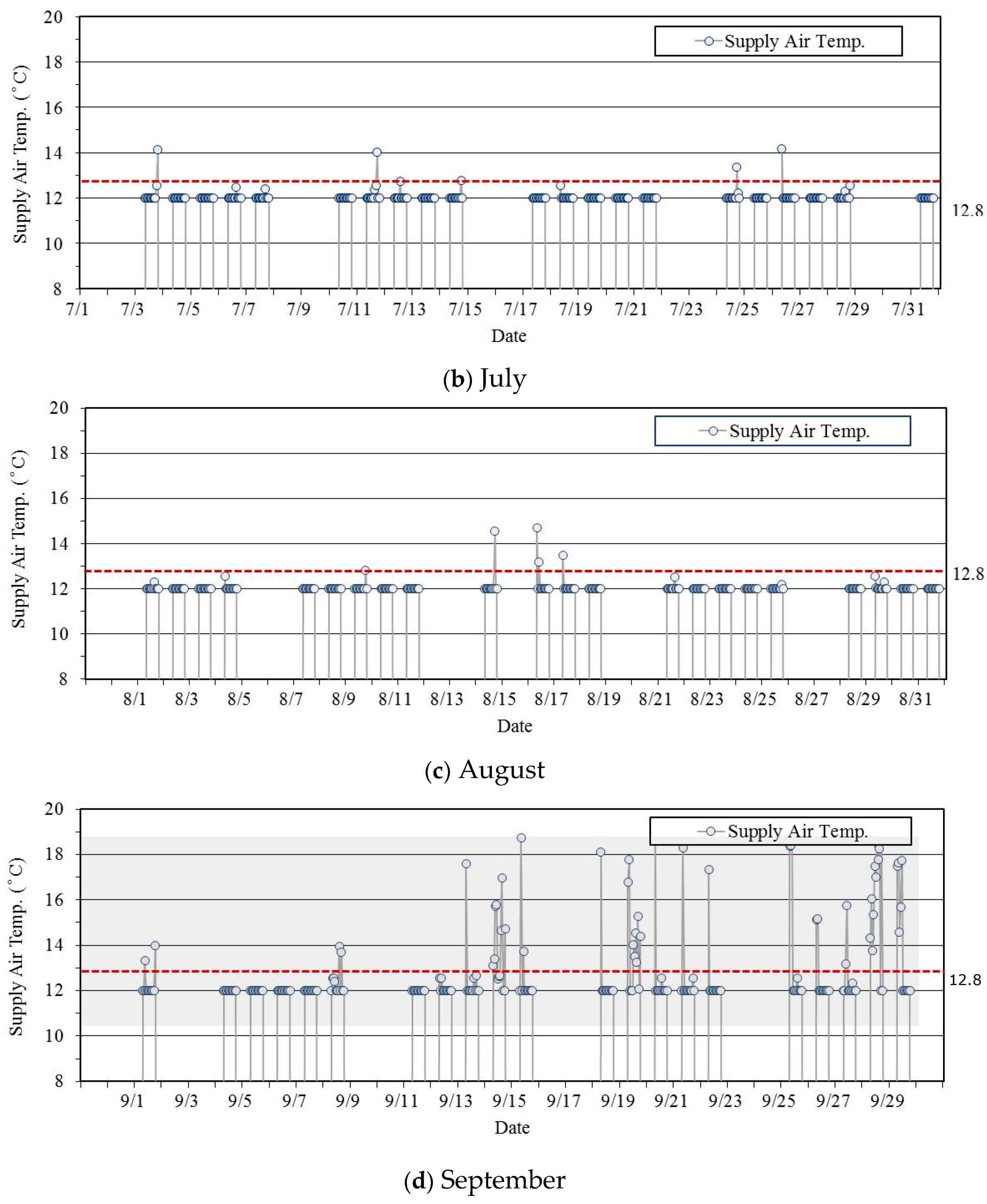

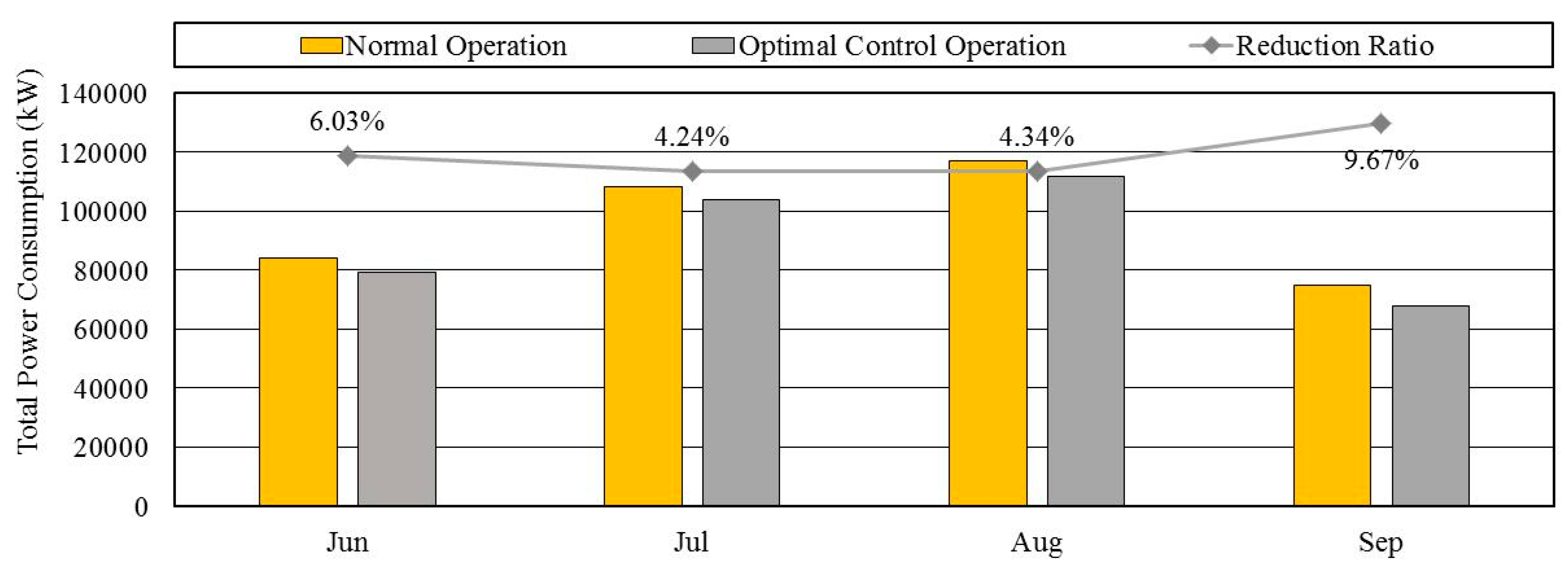
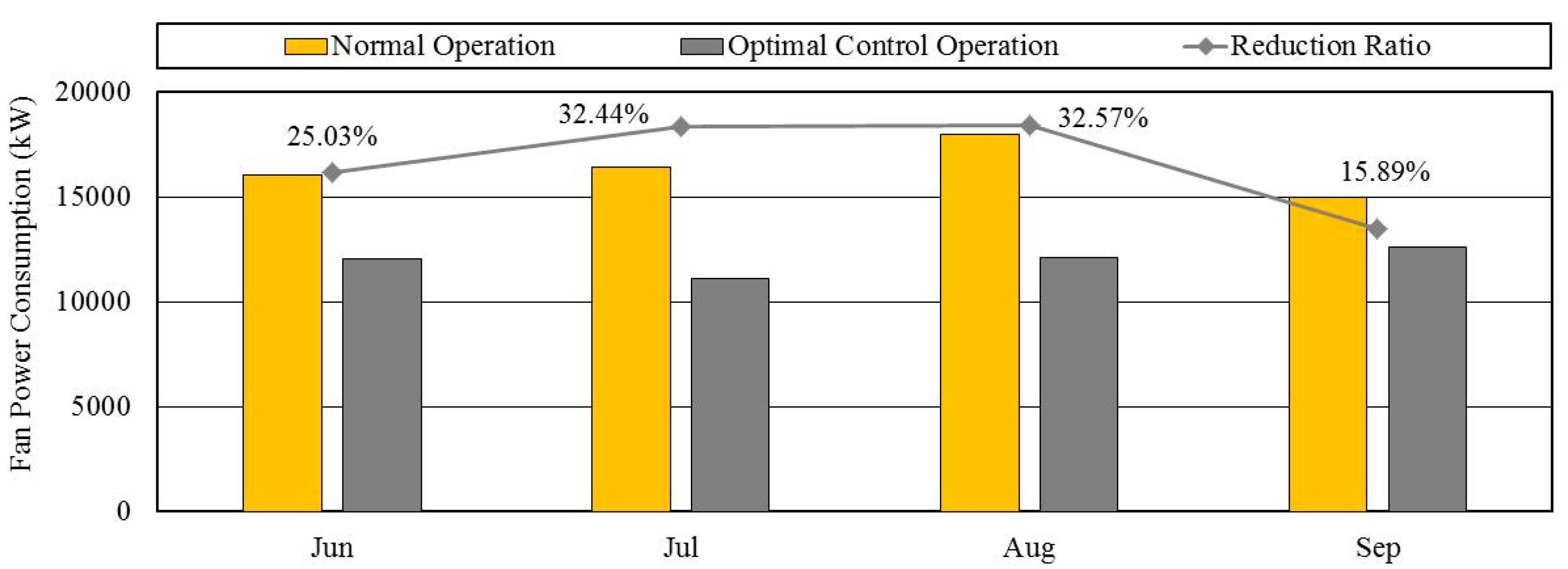
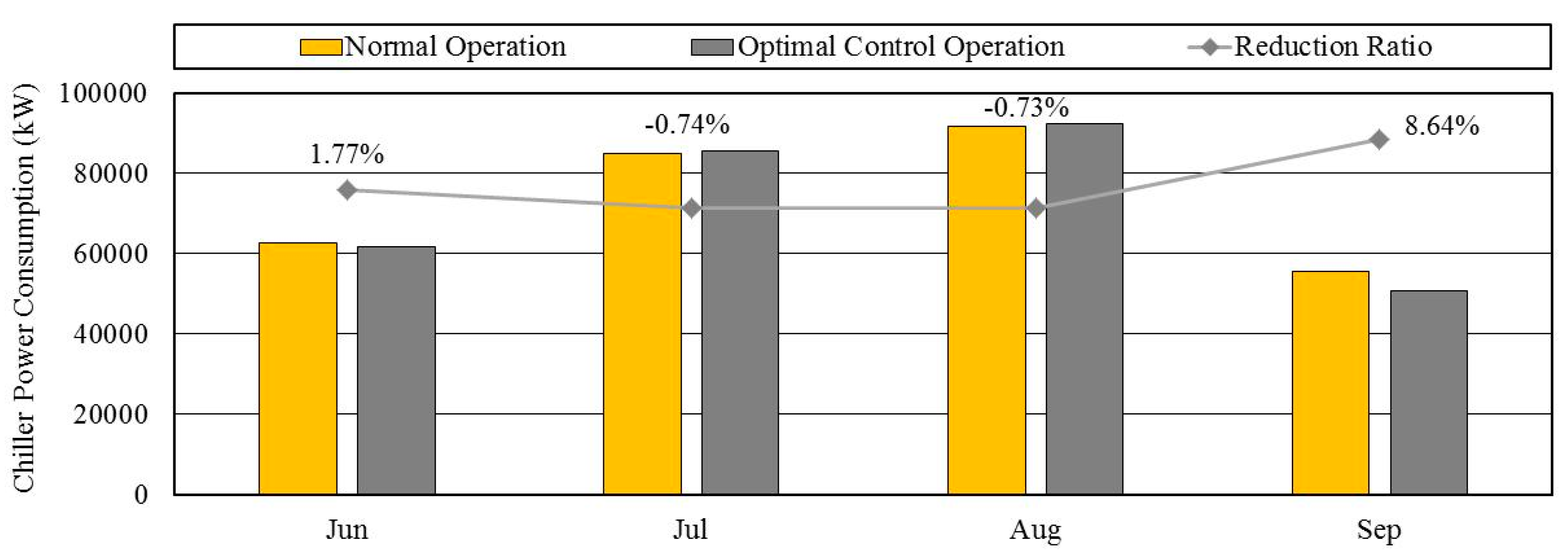

| Component | Features |
|---|---|
| Weather data and site location | Test reference year (TRY) Seoul (latitude: 37.57°N, longitude: 126.97°E) |
| Building type | Large-scale office building |
| Total building area (m2) | 46,320 |
| Hours simulated (hour) | 8760 |
| Envelope insulation (m2K/W) | External wall 0.35, roof 0.213, external window 1.5 |
| Window-to-wall ratio (%) | 40 |
| Setting (°C) | Cooling 26, heating 20 |
| Internal gain | Lighting 10.76 (W/m2), people 18.58 (m2/person), plug and process 10.76 (W/m2) |
| HVAC sizing | Autocalculated (software to be determined) |
| HVAC operation schedule | 7:00–18:00 |
| Case | Control Variable | |
|---|---|---|
| Supply Air Temp. (°C) | Duct Static Pressure (Pa) | |
| ‘Normal’ (Non-optimal) Control Operation | 12.8 | 474 |
| Optimal Control Operation (Range) | Calculate GA (12–19) | Calculate GA (250–620) |
© 2019 by the authors. Licensee MDPI, Basel, Switzerland. This article is an open access article distributed under the terms and conditions of the Creative Commons Attribution (CC BY) license (http://creativecommons.org/licenses/by/4.0/).
Share and Cite
Seong, N.-C.; Kim, J.-H.; Choi, W. Optimal Control Strategy for Variable Air Volume Air-Conditioning Systems Using Genetic Algorithms. Sustainability 2019, 11, 5122. https://doi.org/10.3390/su11185122
Seong N-C, Kim J-H, Choi W. Optimal Control Strategy for Variable Air Volume Air-Conditioning Systems Using Genetic Algorithms. Sustainability. 2019; 11(18):5122. https://doi.org/10.3390/su11185122
Chicago/Turabian StyleSeong, Nam-Chul, Jee-Heon Kim, and Wonchang Choi. 2019. "Optimal Control Strategy for Variable Air Volume Air-Conditioning Systems Using Genetic Algorithms" Sustainability 11, no. 18: 5122. https://doi.org/10.3390/su11185122
APA StyleSeong, N.-C., Kim, J.-H., & Choi, W. (2019). Optimal Control Strategy for Variable Air Volume Air-Conditioning Systems Using Genetic Algorithms. Sustainability, 11(18), 5122. https://doi.org/10.3390/su11185122





